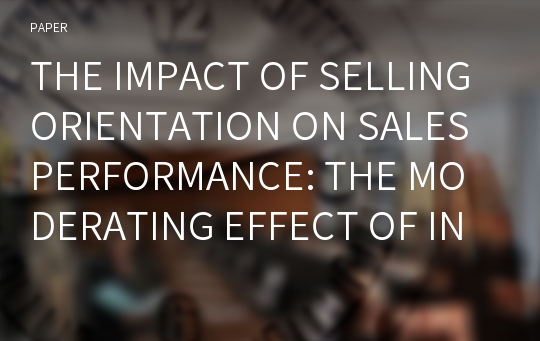THE IMPACT OF SELLING ORIENTATION ON SALES PERFORMANCE: THE MODERATING EFFECT OF INTEGRATION WITH OTHER FUNCTIONAL MEMBERS
* 본 문서는 배포용으로 복사 및 편집이 불가합니다.
서지정보
ㆍ발행기관 : 글로벌지식마케팅경영학회(GFMC)
ㆍ수록지정보 : Global Marketing Conference
ㆍ저자명 : Eunji Seo, Katsuyoshi Takashima
ㆍ저자명 : Eunji Seo, Katsuyoshi Takashima
영어 초록
One of the longstanding goals of both managers and researchers has been to understand the characteristics of effective salespeople. Selling orientation (SO), one of the general approaches of salespeople, has also been referred to in several studies as selling behaviors (Saxe and Weitz 1982; Brown et al. 1992; Jaramillo et al. 2007). SO is the degree to which salespeople place their own needs and/or the needs of the firm before those of their customers by attempting to sell as much as possible to customers. This is exhibited when salespeople are primarily engaged in selling activities that emphasize “getting the sale” (Schultz and Good 2000; Boles et al. 2001). Few researchers focus their attention on SO as one of the sales approaches enhancing sales performance and previous studies generally discuss SO as a factor negatively correlated with customer orientation (CO) (Saxe and Weitz 1982; Brown et al. 1992). These studies suggest SO should be controlled to encourage CO. However, Schwepker (2003) shows in his overviews of recent research that there is not a general consensus on the relationship between SO and individual sales performance. In fact, some studies indicate that SO increases individual sales performance, while others find that it is not an influential factor (e.g. Goff et al. 1997; Boles et al. 2001; Wachnel et al. 2009). Salespeople are required to adopt long-term perspectives as well as short-term sales results simultaneously in a competitive market; thus, it is meaningful to explore whether SO, as an aggressive sales approach, improves individual sales performance and whether SO can be used as an effective organizational indicator. Some studies, on the other hand, argue that the relationship between SO and individual performance is affected by moderating factors, such as differences in performance measurement (subjective or objective) (Jaramillo et al. 2007) and the sales skill level salespeople possess (Wachner et al. 2009). For example, Wachner et al. (2009) tested the moderating impact of three selling skills: interpersonal skills, salesmanship skills, and technical skills. These studies show that various external and individual factors can affect the relationship between SO and performance. Unfortunately, the impact of internal factors, such as integration with other functional members of the organization, has largely ignored. However, integration between salespeople and a variety of functional members is crucial for exchanging information and activating organizational learning (Rouizes et al. 2005), which may affect sales strategy. Indeed, salespeople, as boundary spanners, cooperate with other functional members and provide the firm with external market information (Griffin and Hauser 1990; Singh 1998; Krohmer et al. 2002). On the other hand, salespeople also receive information and support regarding new products and product delivery from other functional members, which benefits individuals’ sales performance. Our study, therefore, aims to examine the performance impact of SO at the level of the individual salesperson. In addition, we test for the moderating effect of integration with other functional members. We use the term integration as proposed by Kahn (2001), in which levels of integration are gauged by the extent of information exchange and personal interaction, and argue that integration, as an option internally available to salespeople, will increase the effectiveness of a sales approach. The indices we use to judge individual sales performance are as follows: the sales figures achieved, the degree to which the salesperson commits to the target sales figure, the number of new customers found, and the level of task innovation displayed in comparison with other members of the same sales team. SO is usually seen as a short-term sales approach. While pure SO cannot have a positive effect on customer loyalty or satisfaction levels (Boles et al. 2001; Schwepker 2003), it is often the most effective short-term selling method. In fact, Wachner et al. (2009) report that SO directly increased individual sales performance in the B to B market settings. Moreover, Boles et al. (2001) reported that SO is not harmful to relationships with customers for in-store retail settings because customers expect salespeople to engage in selling-oriented behavior to some degree. Schwepker (2003) argues that salespeople are more likely to utilize SO in an effort to meet the demands and goals placed on them when managements use the outcome-based measurements (e.g. financial performance) to evaluate their performance. This may mean that when salespeople take a more strongly selling-oriented approach, they increase their attention on selling itself and find effective methods for increasing performance. These discussions show that SO is influential in increasing sales performance. Our first hypothesis, therefore, is: H1. SO positively affects individual sales performance. Meunier-FitzHugh and Piercy (2007) emphasize that the selling of products and services is not exclusive to marketing or sales. Integration between different functional members is vital to improved customer satisfaction and product development performance (Kahn 2001). In addition, Kahn and Mentzer (1998) show that integration between different functional members has a positive influence on performance in terms of department success, overall firm performance and new product development. The authors explain that the information exchange intrinsic to integration allows members to reduce uncertainty, thereby facilitating different types of performance. By transmitting information and interacting with members who work in complementary functions, salespeople are more likely to increase their product knowledge and control time schedules. Accordingly, we expect integration with other functional members to positively impact individual performance. According to Storbacka et al. (2009), sales can play an important role in new product development, which also increases opportunities to broaden customer relationships and modify sales strategies. We argue that when integration is coupled with SO, individual performance improves because integration modifies SO’s aggressive behaviors into an adaptive selling style. Adaptive selling is considered “the altering of sales behaviors during a customer interaction or across customer interactions based on perceived information about the nature of the selling situation” (Weitz et al. 1986, p. 175). Franke and Park (2006) argue that the benefits of adaptive selling behaviors are likely to outweigh the costs of gathering and applying information to specific situations, thereby improving overall individual sales performance. Thus, if salespeople integrate with other functional members in the process of selling products and providing customized service according to customer needs, we expect that the relationship between SO and individual performance will be stronger. On the other hand, role ambiguity of salespeople may be reduced by high SO, which stimulate salespeople to put higher priorities on selling and short-term purpose (Tubre and Collins, 2000; Wachner et al. 2009). Low role ambiguity will make functional integration efficient and effective since allocation and coordination regarding functional roles cost less compared with the situation where the roles are ambiguous. Therefore, when salespeople have higher SO, integration produces more results in shorter time. Hence, on the basis of this reasoning, we hypothesize that: H2. Integration positively affects individual sales performance. H3. The positive relationship between SO and individual sales performance is stronger when salespeople are more integrated with other functional members. 382 questionnaires were handed out to a firm and 186 salespeople including the sales managers filled in the questionnaires. This company’s services and products are related to real estate, car insurance and financial insurance. We chose this particular company because the salespeople are encouraged to use SO approaches and generally integrate with other functional members. Based on Wachner et al. (2009), SO was measured with a three-item indicator that included the following items: “high sales performance is more important than how to accomplish it,” “I try to focus attention on the degree of sales performance compared with others,” and “when a company appraises salespeople, only financial performance has to be considered.” These measures were modified from those used in Wachner et al. (2009) to reflect SO’s short-term transactional manner and emphasis on high financial performance. In addition, the integration with other functional members referred to in Kahn and Mentzer (1998) was also measured using an indicator with the following items: “I frequently exchanges information with other functional members,” “I am actively gathering information from colleagues with different functions,” “critical information is shared between colleagues with different functions,” and “the integration between sales and other functions is possible.” We assessed the validity and dimensionality of our reflective constructs by performing a confirmatory factor analysis (CFA). Our CFA model contains SO (three items, α= .730), integration (four items, α= .839), and performance (four items, α = .826). The model shows an acceptable fit with the data with a χ2 of 153.481 (df = 41, p< .001), a comparative fit index (CFI) of .926, AGFI of 0.846 and a root mean square error of approximation (RMSEA) of .10. We conducted a moderated hierarchical regression analysis to test our hypotheses. Regression results have been provided in Table 1. After mean-centering the interaction variables, multicollinearity was irrelevant because the VIF of the multicollinearity statistic was low level. Model 1 includes control variables and the effects of SO and integration. Model 1 reveals a positive effect of selling orientation (β= .201, p< .01) and integration (β= .358, p< .001) on performance. In Model 2, interaction terms were added. The Model 2 results indicate that the interaction effect between SO and integration on performance is positive and significant (β= .142, p< .05) supporting H3. Post hoc analysis also confirms that integration moderates SO to increase performance. Specifically, examination of the simple regression lines show that there is only an effect of the SO on performance when the salesperson’s integration level is high (t= 3.60, p< .00), but is not significant when integration level is low (t= 1.085, ns). Overall, our results indicate that SO and integration have an important impact on individual sales performance. In addition, as shown by Fig. 1, SO affects individual performance more positively when salespeople integrate more fully with other functional members. These results highlight the tact that, when they co-exist, SO and integration between different functional members contributes to increased individual sales performance. As one of the components of market orientation, integration with other functional members prompts salespeople to consider customer satisfaction. By exchanging knowledge and contributing to internal information flow, integration allows salespeople to develop SO into an adaptive selling approach, thereby increasing sales performance. On the other hand, because high SO results in salespeople using their time and efforts more effectively for performance with integration than low SO, sales performance increases. From a theoretical perspective, the findings we report here taking into account the moderating effects of integration, present a new understanding of the relationship between SO and individual performance. Moreover, our findings have managerial implications. Although SO has a positive effect on individual performance, SO also presents considerable challenges, such as decreasing customer loyalty and endangering salespeople’s job satisfaction (Boles et al. 2001; Schwepker 2003). As a result, the relationship between SO and salespeople’s individual performance requires more discussion and should be considered carefully. Our study shows that sales management could potentially increase sales performance by using cross function teams and setting financial goals, which would simultaneously encourage integration as well as SO (Rouziès et al. 2005).참고 자료
없음"Global Marketing Conference"의 다른 논문
 THE ROLES OF GREEN PACKAGING IN UGLY FOOD PURCHASE INTE..22페이지
THE ROLES OF GREEN PACKAGING IN UGLY FOOD PURCHASE INTE..22페이지 THE IMPACT OF INDUCED AWE ON ETHICAL TOURIST BEHAVIORS5페이지
THE IMPACT OF INDUCED AWE ON ETHICAL TOURIST BEHAVIORS5페이지 A BIBLIOMETRIC ANALYSIS OF SPIRITUAL TOURISM RESEARCH15페이지
A BIBLIOMETRIC ANALYSIS OF SPIRITUAL TOURISM RESEARCH15페이지 SOCIAL NETWORK ANALYSIS AND RESPONSE TIME TESTING: CONS..11페이지
SOCIAL NETWORK ANALYSIS AND RESPONSE TIME TESTING: CONS..11페이지 THE EFFECTS OF PARA-SOCIAL INTERACTION ON ONLINE CELEBR..3페이지
THE EFFECTS OF PARA-SOCIAL INTERACTION ON ONLINE CELEBR..3페이지 THE INFLUENCE OF OPINION LEADERS ON DAILY DEALS USER’S ..3페이지
THE INFLUENCE OF OPINION LEADERS ON DAILY DEALS USER’S ..3페이지 HOW IMMERSIVE RETAILING AFFECTS CONSUMERS’ URGE TO BUY:..6페이지
HOW IMMERSIVE RETAILING AFFECTS CONSUMERS’ URGE TO BUY:..6페이지 KEY TO SUPERSTARDOM IN A GLOBALISED MARKET: THE ROLE OF..6페이지
KEY TO SUPERSTARDOM IN A GLOBALISED MARKET: THE ROLE OF..6페이지 A POST-PANDEMIC LOOK AT TOURISTS’ PERCEIVED COOLNESS OF..4페이지
A POST-PANDEMIC LOOK AT TOURISTS’ PERCEIVED COOLNESS OF..4페이지 EXTRACTING OFFLINE RETAIL SHOPPING PATTERNS: OLLABORATI..5페이지
EXTRACTING OFFLINE RETAIL SHOPPING PATTERNS: OLLABORATI..5페이지

























